Transglutaminase (meat glue)
Transglutaminase, also called meat glue, is an enzyme that can be used to bind proteins to make uniform portions of fish filet, tenderloins, etc. that cook evenly, look good and reduce waste. Transglutaminase can also be used for creative applications in modernist cuisine such as making shrimp noodles, binding chicken skin to scallops or even making checkerboards with different types of fish. How can you do such a thing? Simply apply some transglutaminase on each side of the protein to bind, press the sides together and let it rest refrigerated for a few hours.
Transglutaminase ‘meat glue’ was introduced into the modernist kitchen by Heston Blumenthal and is currently being used by some of the world best chefs such as Wylie Dufresne to:
- Make uniform portions of fish filet, tenderloins, etc that cook evenly, look good, and reduce waste.
- Bind ground meat mixtures like sausages without casings.
- Make meat combinations like chicken skin and scallops.
- Produce creative dishes like meat noodles, fish checkerboards, etc.
Pure transglutaminase is too concentrated to use easily so the commercial products are blended with other ingredients to make it adequate for specific applications. The two most popular Transglutaminase products used in the modernist kitchen are Transglutaminase TG2N (equivalent to Activa RM) and Transglutaminase TGF (equivalent to Activa GS).
As with everything in cooking, there are some rules and warnings that you need to adhere to in order to safely and effectively use this product to your advantage, and we’re going to teach you all of those in the next few paragraphs, so stick around!
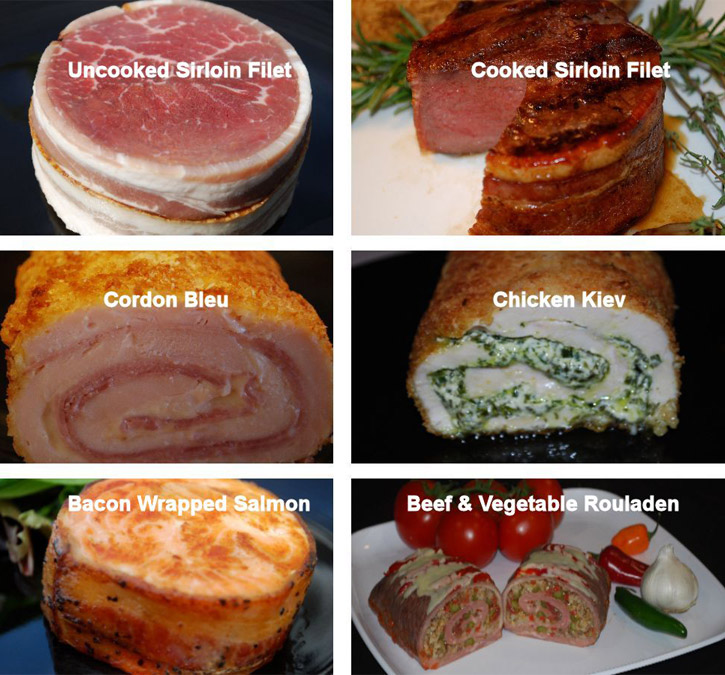
Transglutaminase Origin
Transglutaminase is an enzyme that stimulates a bonding process at the cellular level with the amino acids lysine and glutamine in proteins. It’s not technically glue, though that’s what it’s often referred to as. It’s a protein that’s present naturally in both plant and animal systems. The product used in kitchens is created from natural enzymes using a fermentation process. The commercial transglutaminase product is called Activa.
Transglutaminase Function
Regardless of whether you’re a traditional cook or prefer to push the envelope with modernist cuisine techniques, there are practically endless ways that you can utilize Transglutaminase ‘meat glue’. The original purpose was to bind Japanese surimi, the imitation crab meat made from fish. Since then, the uses of the products have been expanded so that now the only real limitation is your imagination.
With Transglutaminase ‘meat glue’ you can bind:
Making Uniform Portions
Note: use a max of two or three large pieces to obtain high quality results with imperceptible seams and great texture. Remember, you are not trying to make chicken nuggets, leave that for the industrial manufacturers.
- Beef tenderloins to prevent wasting the ends, obtain even cooking and nice looking portions. Joining two tenderloins from head-to-tail, essentially recovers the less useful tapered ends of the product.
- Thin cuts of meat such as flap steaks in order to cook at temperatures such as rare and medium rare that are difficult to hit due to thickness.
- Fish filets head-to-tail binding to make good use of the thin tail sections.
- Rolled fish filet or thin meat cuts to create tubes that can be cooked evenly and sliced into even portions.
- Remove bone, fat, tendons from meat and bind into a single chunk.
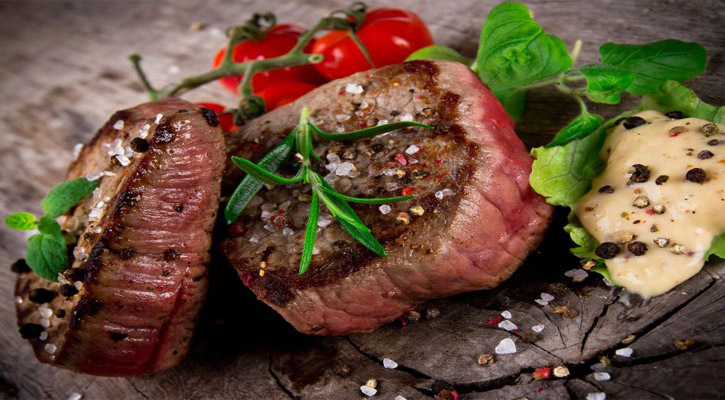
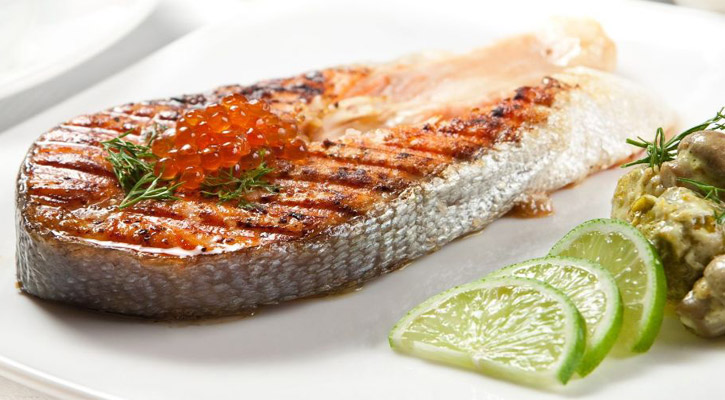
Combining Disparate Proteins
Note: this should be done with proteins that have similar cooking temperatures.
- Different types of fish in order to create new flavor combinations and visual effects such as salmon and Hamachi checkerboards, striped or laminated arrangements.
- Bacon and scallops or bacon and tenderloin perfectly bind without the use of skewers.
- Chicken skin and scallops, salmon or shrimp for a new great flavor combination and crunchy texture.
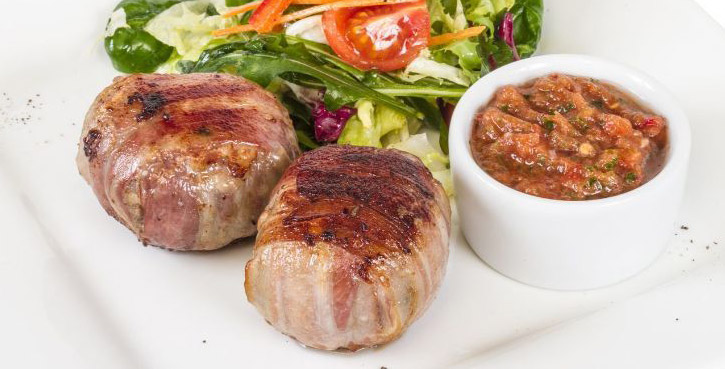
Binding Ground Meat
- Ground meats such as sausage without using casing.
- Meat noodles such as the shrimp noodles from modernist Chef Wylie Dufresne of WD-50.
Binding Non-meat Products
Chef Dufresne binds non-meat items with Transglutaminase in order to make interesting shapes such as pastas or blocks.
- Gelatin and barley to make barley blocks that can then be charred.
- Peanut butter to make ultra-thin peanut butter sheets that are then cut into thin slices to make ‘noodles’. These noodles are used to make a “Pad Thai” dish with the same flavors as the original dish but with different components providing those flavors.
- Peas and carrots to make a block.
Other Uses of Transglutaminase
- Molecular gastronomy Chef Dufresne adds Transglutaminase to a fois gras terrine that can be seared and served hot without melting.
- To prevent emulsified forcemeats such as boudin blanc from splitting when cooked.
- Strengthens noodles that are low in gluten, such as buckwheat soba noodles.
- Thicken egg yolks and dairy products. Commonly used to make yoghurt to contribute to syneresis prevention and increase the consistency.
- Strengthen dough mixtures.
- Increase yield in Tofu production.
Who’s Using Transgulaminase in modernist cuisine?
Transglutaminase is used in the top kitchens around the world. As we mentioned before, Chef Wylie Dufresne of WD40 uses Transglutaminase in several of his famous dishes, but Chef Heston Blumenthal of the Fat Duck was the first Western chef to utilize meat glue in his restaurant.
Molecular gastronomy Chef Blumenthal uses it to make a ballottine of mackerel in which he breaks down the fish, removes the bone, then reconstructs it to make his famous Ballottine of Mackerel ‘Invertebrate’. A ballottine is a roll of boned and stuffed poultry, meat or fish. He wanted to take this idea a step further and create what looked like a cross-section of a whole fish that had no backbone running through it.
Blumenthal also uses transglutaminase in his famous Ballottine of Anjou Pigeon to create seamless roulades of pigeon breast. He just didn’t like how the small and skinless pigeon breast looked on the plate and used meat glue to make it more attractive.
Chef Blumenthal also places black truffle slices between two salmon filets that are bound with transglutaminase in his delicious Salmon Poached in Liquorice Gel dish.
Chef Wylie Dufresne uses meat glue to make flourless noodles from shrimp, fish, and other meats as well as to make thin cuts of meat such as flap steak thicker in order to more easily cook them to rare and medium rare. He uses it to bind strips of cod into a tubular shape that can be sliced and to wrap an egg yolk with thin slices of chicken meat. Finally, he uses it to bind non-meat ingredients such as barley, blocks, peanut butter noodles and other starchless pasta made from milk or sesame paste.
Chef Sean Brock uses transglutaminase meat glue to make "lobster Cheetos", a light-as-air crustacean take on the classic cheese puff , fried in olive oil and served with different dipping sauces.
How Does Transglutaminase Work?
To begin, Activa meat glue, the commercial product, isn’t pure transglutaminase. It’s mixed with fillers such as maltodextrine because pure tranglutaminase is too concentrated to work with easily. Depending on the type of Activa that you use, there are other functional ingredients as well, though the primary ingredient is always transglutaminase.
As we’ve already discussed, transglutaminase doesn’t actually glue the meat together. Instead, it acts as a catalyst to stimulate a bonding process in the lysine and glutamine in the protein. Depending on the formulation that you use and the type of protein that you’re working with, you may use either a dry rub or a slurry mixed with water.
Typically, how much meat glue to use is determined by the weight, type of protein and application. You’ll use anywhere from .05% to 2%. A percentage between 0.75% and 1% is what you’ll end up needing most of the time. Keep in mind that when binding meat, the Transglutaminase enzymes have a tendency to firm and toughen the flesh so it is important to use just the minimum necessary quantity and no more, especially with delicate ingredients such as fish.
This is a process that takes some time, though. Since it’s an actual chemical reaction instead of instant glue, you need to allow 4-24 hours for the meat to bind. Standard procedure is to prep the day before you plan to use the bound meat.
Regardless of which type of transglutaminase you use, you’ll need to do your best to remove all air bubbles from between the pieces that you’re binding. You can then vacuum pack it if local food ordinances permit, or roll it in plastic wrap in order to hold it together in the desired shape until the chemical process finishes. You can even cook it right in the plastic wrap!
Do your best to get all forming and shaping done within 20 – 30 minutes, then let the meat sit wrapped or weighted for 4-24 hours.
Transglutaminase Storage
Because you’re dealing with live enzymes, transglutaminase does have a limited shelf life. As a matter of fact, you need to keep it at cool temperatures or refrigerated until you use it. Once it’s open, you need to wrap it tightly and store it in the freezer. Only take out enough to use immediately.
Is Transglutaminase Safe?
There is a lot of controversy about the safety of transglutaminase, but it has been approved by the FDA as “GRAS and by the USDA. It’s approved in the US, Japan, Europe and numerous other countries. All commercial products that contain it are labeled either as “transglutaminase” or “enzyme”.
Safety Precautions When Using Transglutaminase
As with any food product, you need to be careful about cross-contamination issues. Gluing meet puts the outside of the meat, which usually has higher content of bacteria, on the inside of the restructured piece. Be particularly careful when cooking to rare temperatures. Use fresh products, with low bacteria content and do not glue them warm. Chilled cuts will slow the bacteria growth. Treat glued meet as you would ground meat.
Transglutaminase Types
Pure transglutaminase is too concentrated to use easily so the commercial products are blended with other ingredients to make it adequate for specific applications. The two most popular Transglutaminase products used in the modernist kitchen are Transglutaminase TG2N (equivalent to Activa RM) and Transglutaminase TGF (equivalent to Activa GS).
Transglutaminase TG2N (equivalent to Activa RM)
Transglutaminase TG2N is particularly effective for products that have lower protein content. Transglutaminase TG2N is well suited for binding difficult proteins such as chicken breasts and cooked meats. To bind large pieces of meat, such as two tenderloins, Transglutaminase TGF is mostly recommended.
Transglutaminase TG2N contains milk protein so it does carry an allergen and will activate much quicker than Transglutaminase TGF. Transglutaminase TG2N meat glue needs to be used within 20 minutes or the product will begin to bond to itself.
Transglutaminase Activa GS (equivalent to Activa GS)
Transglutaminase TGF is particularly effective to bind large pieces of meat, such as two tenderloins to prevent wasting the ends, obtain even cooking and nice looking portions. Transglutaminase TGF is also highly effective for fish/seafood items.
The Science of Transglutaminase (meat glue)
Transglutaminase is an enzyme that can catalyze the formation of covalent bonds between the amino acid residues Lysine and Glutamine in proteins.
Transglutaminase forms isopeptide bonds (cross-links) between lutamine and Lysine residues in proteins. An isopeptide bond is a chemical bond found in proteins in which participating atoms share electrons. Isopeptide bonds are stronger than some other chemical bonds (e. g. hydrogen bonds) and cannot easily be broken up by normal heating.
Transglutaminase improves the physical properties of food (e. g. textural properties like firmness and elasticity).

As any enzymatic reaction, the Transglutaminase reaction is influenced by the factors time and temperature. Higher reaction temperatures require less reaction time, whereas reactions at a lower temperature evolve slower. The type of food to be processed and the desired physical properties determine the necessary relation between time and temperature for the reaction.
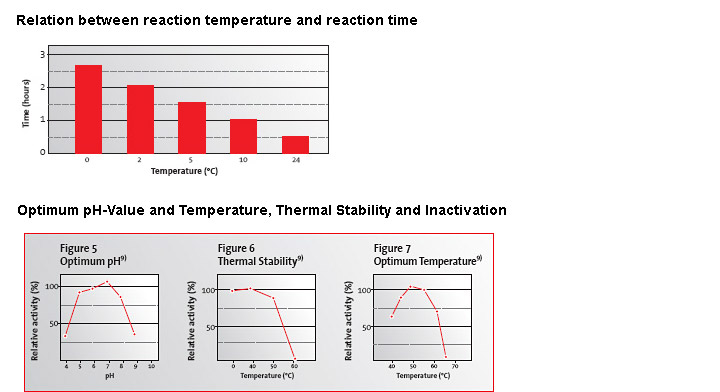
When activity is measured using synthetic substrates, Transglutaminase shows high activity in a wide pH-range, i. e. between pH-value 5 and 8 (Fig. 5). Although the enzyme is stable up to temperature of 55 °C, activity decreases gradually after about 50 °C (Fig. 6). The optimum temperature for a 10 minute reaction is therefore 50 °C to 55 °C (Fig. 7).
* Enzymatic activities were measured at 37 °C and pH-value 6. Thermal stability shows the residual activity after heating at each temperature for 10 minutes at pH-value 7.
Source: Cooking Issues by Dave Arnold, Ajinomoto, Harvard lectures.





